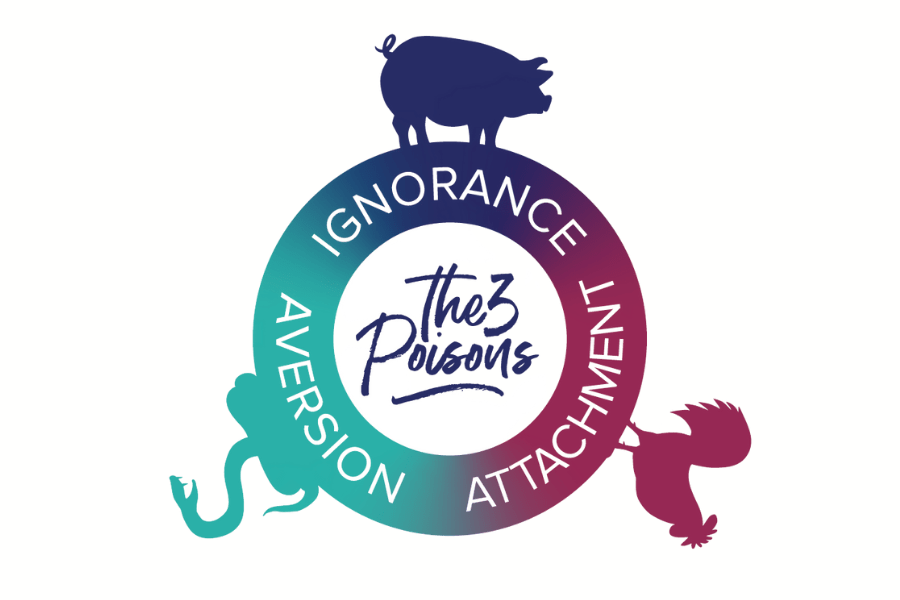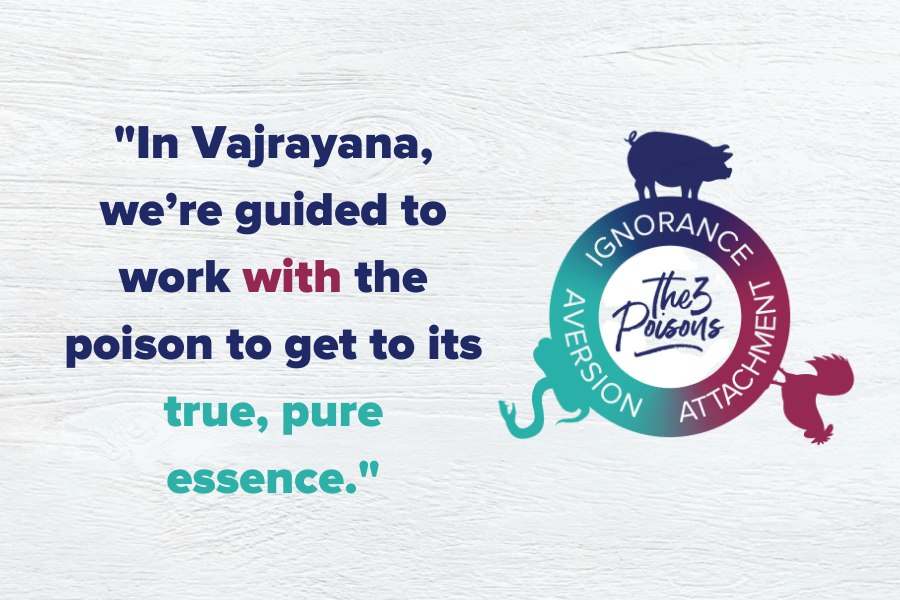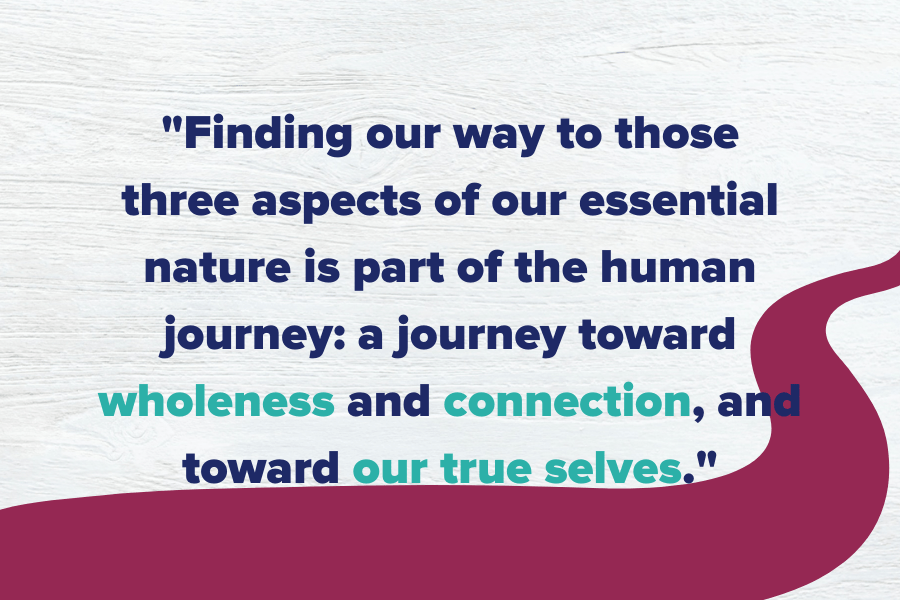The first step in working with anything is awareness, right? Let’s begin by reviewing the Three Poisons, so we can clearly see and recognize these poisons. Then we can dive into working with them.
What are the Three Poisons of Buddhism?
- Attachment refers to feelings of greed, lust, and passion. It is represented by a rooster. The Ego is at the center of this Poison — we always want more of whatever feels good to our Ego. An extreme example would be disregarding the needs of others or even endangering others to get the object of one’s desires, or an attitude of only wanting or caring for things that we like. However, attachment also offers a path to enlightenment, as it carries the possibility of love and connection.
- Aversion refers to feelings of aggression, anger, and hatred. It is represented by a snake. Its opposite is loving kindness. In the same vein as Attachment where we only try to get the things we want, when we experience Aversion, we push away (usually aggressively) the things that we dislike. If we allow our ignorance to take over, we can conjure up hatred for the things that we dislike and the people we see as blocking our desires.
- Ignorance refers to feelings of delusion, confusion, and dullness. It is represented by a pig. This poison is rooted in the delusion of believing we are separate, leading us to prioritize our own pleasure over the suffering of others, ignoring everyone’s reality but our own. Unlike attachment and aversion, ignorance carries no alternative path to enlightenment because we will continue to suffer and cause suffering when we don’t see our interconnected reality. This can be experienced as an inability to see the truth or reality of ourselves or the world around us. Whenever our perceptions are different from reality, we will experience and cause suffering. When we cling to ignorance, we forget our interconnectedness and see ourselves as separate from others. We don’t have to look far in society to see the pain that is caused by ignorance.
Please note that we hold no personal grudges against roosters, pigs, or snakes! They are simply symbols of each poison in traditional teachings.
Why are the Three Poisons important?
The first step to ending suffering and finding enlightenment is to become aware of these Poisons, noting how they manifest in different ways in our everyday lives.
Some are more potent than others depending on our own experiences. And sometimes, we may experience all three. We unfortunately can’t control the presence of these poisons — they arise in all of us as part of the human condition. But we can choose whether to feed them and allow them to fester once we recognize them.

How do you overcome the Three Poisons?
Despite all of the work we may have done on ourselves, at one point or another we all can use some help with our relationships. At work, at home, wherever we are, we most likely come into contact with others. Sometimes the interactions are smooth and enjoyable. Other times, they may be cringeworthy and bring us some regret.
Without awareness, we tend to blame other people or objects for our emotions, which typically leads to regretful behavior. When was the last time you walked away from an interaction and thought, “They/that made me so [insert poisonous emotion of choice]?”

Second, it means that you are working with what Buddhism calls a “poisonous emotion” or three. When we speak of literal poison, it would be nice to avoid all of them, all the time. In regard to the Three Poisons, complete avoidance is not always possible. We can’t control when or how emotions arise, but we can control how we respond to those emotions. Once we’re already feeling the emotion, we could take an antidote like applying forbearance to anger.
In Vajrayana, we’re guided to work with the poison to get to its true, pure essence.
Is there such a thing as a positive core to these poisonous emotions?
Well, since the essence of everything in creation is pure, what could be the essence of even
these emotions?
But HOW is that possible?
What is that core like?
And HOW do we peel that onion to get to the pure, positive core?
The answer is contained in this maxim, “Three objects, three poisons, and three seeds of virtue.”

If you’ve ever felt like you have a huge menu of feelings, you’re right! The Buddha spoke of over 84,000 emotions. That’s a lot of feelings! Fortunately, we can sort them into the categories of the Three Poisons: Attachment, Aversion, and Ignorance.
If we feel anger, we will often look for an object to blame for our anger. This could be a person or a situation. Then most likely we will look to the object and say, “You made me mad!” or something along those lines. When we hear those words in our minds or out loud, it’s a signal to pause and look inward. This may be a good time to send yourself
some Loving Kindness as you navigate your anger.
We can shift our focus from the object to investigating the poison that we’re experiencing. We can hold the anger in our hands, very lightly, and look at its essential qualities. As we peel away the layers of ego around our anger, we arrive at its core: Mirrorlike Timeless Awareness—an aspect of the wisdom of the Ground of Being. It’s always there, but we get so distracted by the surface “waves” that we can’t see the “depths of the ocean.”When we do, this is a “seed of virtue”, as the maxim says.
If we find our way to the essential nature of each poison, we can find at the heart/core of attachment, the Timeless Awareness of Discerning Wisdom, and our ignorance to the Timeless Awareness of the empty (non-solid) Ground of Being.
Finding our way to those three aspects of our essential nature is part of the human journey: a journey toward wholeness and connection, and toward our true selves.
Our natural state is pure Timeless Awareness, pure love, and pure connection. When we pull our attention away from the object to our own poisons and use them in this way, we make fewer reactionary messes and decrease our human suffering. Everyone around us should thank us ! 
For more Buddhist teachings like this and additional meditation practices, join a Learning Circle! Follow this link for more information! If you’d like to jump right into meditation practice, HERE is a ten-minute Loving Kindness meditation with Lama Tsomo

